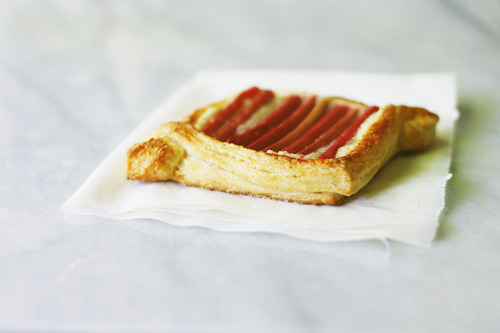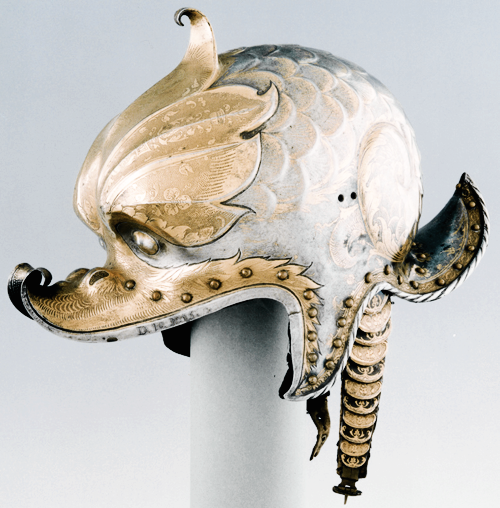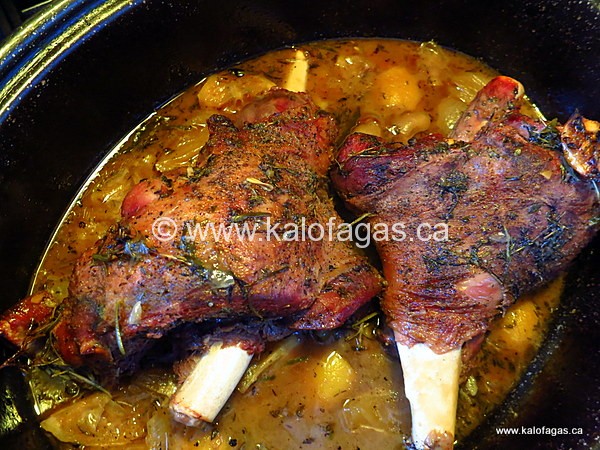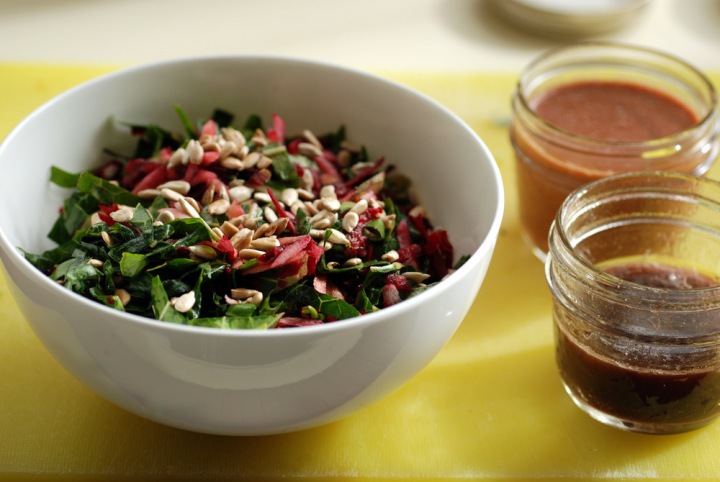I went back and forth on whether or not I should write about these rhubarb Danishes. The trouble is, they're fussy. The dough requires a start the night before you want to bake, and so does macerating the rhubarb, and that's still only two of the three components done. And that dough, one that usually accepts a boost of whole wheat, demands all-white flour for truly gratifying puff and flake in this free-standing rendition. What's more, the quantities are awkward; in regards to the volume of rhubarb, there is the need for a certain surface area, not really weight, making it difficult to pin down a specific amount. A batch of the almond cream (the last piece to this puzzle) yields more than needed; in light of which, there's the option of making only a half recipe with clumsy math, or doubling the pastry and rhubarb, or accepting that there will be leftover and making almond croissants with what remains.
After the details and wait, these Danishes are frustratingly good. The pastry is crisp at the edge but tender still. The almond cream is fragrant and ever-so-slightly-gritty, providing delineation between the smooth layers of the pastry below and the yielding rhubarb above; rhubarb which, only lightly sweetened, retains a glinting sharpness, cutting back the richness of the overall bite.
WIthout naming names, there's a few folks who have made habit of putting away two (two!) per sitting, with no crumb neglected on the plate. By all accounts these Danishes are worth the trouble.

Scratch that. It's not trouble to make these, it's work. Not even difficult work, only an involved process.
There was a reason behind the endeavour, besides really liking the idea of rhubarb Danishes, and that was the rhubarb itself. Sean brought bunches from a farm stand, two big bundles of stalks a few feet in length with leaves attached. He laid them in my arms in much the way a bouquet is handed to a crowned beauty queen, cradled in the crook of the elbow. These hot pink lookers, firmly pliant and none wider than my index finger, they called for similar pageantry.
They needed a proper stage, not hidden under a crust or crumble, but left as they were for the most part and shown off. Danish dough as backdrop to neatly rowed rhubarb would do exactly that.

I also know myself well enough to admit that I made these Danishes because I was avoiding another job I should have been doing. As I have a tendency to do when I'm daunted. I look for a different challenge to skirt around the one that really scares me.
I finally got around to listening to the audio copy of "The War of Art" (Warner Books, 2002) by Steven Pressfield that Sean put on my phone. When I've been playing it for a while and stop, I feel as though I've broken the surface after being underwater. It's an immersive listen, as Pressfield accounts the process and pitfalls of a creative life. I've been thinking of getting a hard copy, wanting to have the words laid out before me instead of rewinding and replaying the recording as often as I do.
The first chapters of the book are about resistance, about what it means to commit yourself to work. In talking about the difficulties in getting started and the dangerous fear of coming to the end of a project, I thought about aiming for the middle. That comfortable place when momentum is behind you and you're not thinking yet about the sprint to the finish. It's when we fall into stride. Infuriatingly, despite anxiety of beginning, the only way to get there is by putting your head down, setting your shoulders, and simply do the work.
There's no way around it; the following recipe reads long and boring and far too much effort to be worth it. It's doable. Promise. I've made them once a week for the last three. As Pressfield says:
"Set one foot in front of the other and keep climbing."
(I keep repeating that part.)

RHUBARB DANISHES WITH ALMOND CREAM
A collection of recipes. The ingredients for the almond cream (with added vanilla bean) come from Bouchon Bakery (Artisan, 2012) by Thomas Keller and Sebastien Rouxel. It is a book you want on your shelf when it comes to anything baked, full of insights and tricks, and essential recipes. With great respect to the authors, I've rewritten their instructions — with larger capacity stand mixers, I find the small batch of almond cream (as this amount is called in the book) easier to make by hand, especially if you chose to halve the recipe. What's below reflects that.
FOR THE RHUBARB
- Approximately 1 1/2 pounds (700g) fresh rhubarb, trimmed of leaves but left whole
- 1/3 cup granulated sugar
- 2 tablespoons water
- seeds scraped from half a vanilla bean, plus the pod
FOR THE PASTRY
- One recipe quick Danish dough, with white bread flour used to replace the same quantity of whole wheat
FOR THE ALMOND CREAM (makes approximately 1 1/2 cups, more than needed)
- 1/2 cup + 2 1/2 tablespoons (73 grams) almond meal
- 2 1/4 teaspoons (7 grams) all-purpose flour
- 2.5 ounces (73 grams) unsalted butter, at room temperature
- 1/2 cup + 2 tablespoons (73 grams) powdered sugar
- Seeds scraped from half a vanilla bean
- 2 tablespoons + 2 teaspoons (44 grams) lightly-beaten eggs, see note
TO ASSEMBLE
- 1 egg, beaten for egg wash, see note
- Granulated or sanding sugar for sprinkling
METHOD
Up to 24 hours before you want to bake, trim the rhubarb stalks to fit in a 9x13-inch dish. Combine the sugar, water, vanilla bean and pod in a saucepan. Bring to a boil over medium heat, then reduce the heat to low and simmer for 2-3 minutes, stirring, until the sugar is fully dissolved. Pour the hot syrup over the prepared rhubarb, turning the stalks to coat. Leave at room temperature to cool, then cover and place in the fridge at least overnight and as much as a full day, shuffling the rhubarb around in the syrup now and again.
The night before you want to bake, start the Danish dough. (You will complete the folds and finishing in the morning.)
The next day, about 2 hours before you want to bake, make the almond cream. Sift the almond flour into a medium bowl; break up any lumps in the sieve, and add to the bowl. Sift in the all-purpose flour and whisk together.
Place the butter in a medium bowl and beat with a silicone spatula or a hand mixer until the butter lightens to about the consistency of mayonnaise and holds a peak when the spatula is lifted. Sift in the powdered sugar, stir to incorporate. Once blended, beat the sugar and butter together until fluffy, around 3 minutes. Scrape down the bottom and sides of the bowl. Add the almond mixture in 2 additions, stirring to combine, then stir in the vanilla. Pour in the eggs and mix until smooth. Transfer to an airtight container, pressing a piece of plastic wrap against the surface to prevent a skin from forming. Refrigerate until cold, about 2 hours. (The cream can be made up to 4 days ahead of time.)
30 or so minutes before you want to bake, finish the Danish dough by completing 5 turns (folds). Chill for 20 minutes. (Dough can be made ahead and frozen, then defrosted in the fridge before using.)
To assemble, preheat an oven to 375°F / 190°C. Line a baking sheet or half sheet pan with parchment paper and set aside.
On a lightly-floured work surface, roll the Danish dough to a 11x22-inch rectangle. Cut the dough into eight 5 1/2-inch squares. Refer to this diagram, and decide which shape you want to make. If making the vol-au-vent or envelope as I did, working one at a time, fold each square diagonally onto itself (forming a triangle, with corners lined up neatly). Leaving a thin border, cut a thin line starting from the bottom right corner of the triangle, parallel to the edge, almost up to the top. Repeat on the other side, leaving the tip attached. Unfold the package, brush with egg wash, then pull one of the cut edges over the other, lining it up with the interior edge of the square. Do the same with the other side, pressing lightly to seal, then place on prepared baking sheet. Repeat with remaining squares.
Spread the well of each shaped Danish with about 1 tablespoon of almond cream. Remove rhubarb from the sugar syrup, draining any excess liquid back into the dish. Trim the rhubarb to fit the pastries and line them up to cover the almond cream. (There may be rhubarb left over, do not discard.) Sprinkle entire Danish with sugar. Set aside to rise in a warm, draft-free area for 20 minutes.
Meanwhile, pour the rhubarb sugar macerating liquid into a saucepan along with any remaining rhubarb, cut to into chunks. Bring to a boil over medium heat, then reduce the heat to a simmer. Cook, stirring, but not breaking up the rhubarb, until the liquid has thickened to a light syrup. With a slotted spoon, remove the rhubarb from the syrup. Turn off the heat but leave the syrup on the stove to keep warm.
Bake pastries in the preheated oven until puffed and golden, around 20 minutes. With a pastry brush, glaze the rhubarb and almond filling with the syrup. Remove the pastries to a baking rack to set for a few minutes, then serve warm.
The Danishes are best eaten the day they are made.
Notes:
- You may have egg left over from making the almond paste. This can be kept aside and used for the egg wash. (If amount looks scant, you can bulk it up with a bit of heavy cream.)
- The rhubarb removed from the syrup can be recombined with any extra glaze and served over ice cream or yogurt.
- If process shots will be of some aid, here is one, and another.













































![PowerPoint Slide Show - [salonika [Compatibility Mode]] 05022013 53631 PM](http://www.kalofagas.ca/wp-content/uploads/2013/03/PowerPoint-Slide-Show-salonika-Compatibility-Mode-05022013-53631-PM.jpg)






 SERVES 2-4
SERVES 2-4








 SERVES 4-6
SERVES 4-6 SERVES 6
SERVES 6
 SERVES 4
SERVES 4



 SERVES 6-8
SERVES 6-8 

 317
ratings
317
ratings 










































































